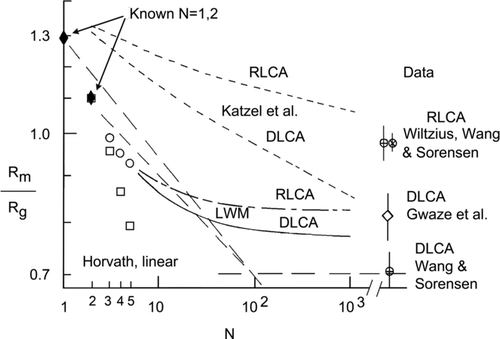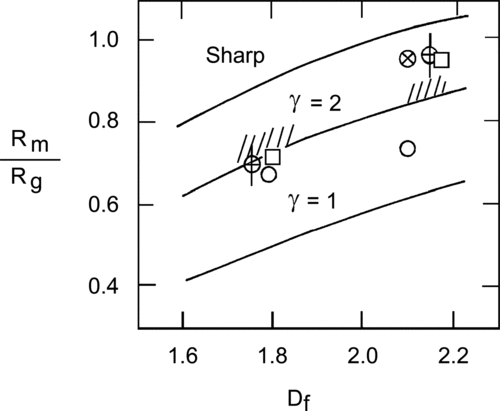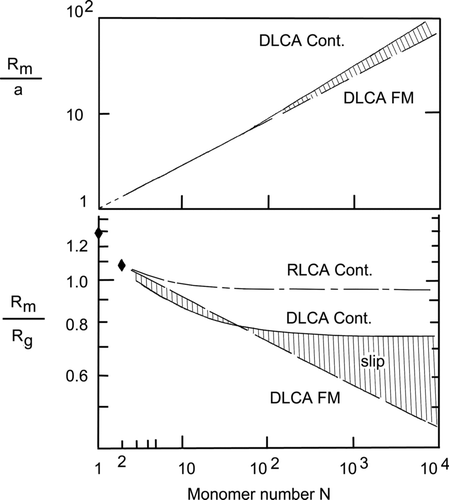Figures & data
FIG. 1 Transmission electron micrograph of soot aggregate particles sampled thermophoretically from an ethylene/air laminar, diffusion flame.

FIG. 2 Preliminary graph of the ratio the aggregate mobility radius to the radius of gyration, β = Rm/Rg, versus the number of monomers (primary particles) in the aggregate N in the continuum limit. Solid diamonds are exact values known for the N = 1 and 2 limits. Data include: open squares are the data of CitationHorvath (1974) for linear chains, circle with X the data of CitationWiltzius (1987) for RLCA fractal aggregates, circles with plus sign are the data of CitationWang and Sorensen (1999) for both DLCA and RLCA fractal aggregates, square open diamond the data of Gwaze et al. (2006) for DLCA fractal aggregates. Theory includes: solid line CitationLattuada et al. (2003a), designated by LWM, for DLCA fractal aggregates, dashed dot line Lattuada et al. for RLCA fractal aggregates, medium dashed line CitationKatzel et al. (2008), and long dashed lines “backbone” functionalities for DLCA fractal aggregates proposed in the text.

FIG. 3 Aggregate mobility radius normalized by the monomer (primary particle) radius, Rm/a, versus number of monomers in the aggregate, N. Open symbols designate continuum regime, closed free molecular regime. Data are open squares from CitationHorvath (1974) for linear chains and closed triangles from Cho et al. (2007) for random aggregates. Theory includes: closed squares CitationChan and Dahneke (1981) for linear chains, closed circles CitationMackowski (2006) for DLCA fractal aggregates, open circles CitationLattuada et al. (2003a) for DLCA fractal aggregates, and open diamond Binder et al. for a compact seven-star. Lines represent power laws Rm = aNx for x = 0.46 and 0.56.

FIG. 4 The ratio the fractal aggregate mobility radius to the radius of gyration, β = Rm/Rg, for large N in the continuum regime versus aggregate fractal dimension, Df, calculated for three different density correlation function cutoffs using EquationEquation (16). Cross-hatch regions represent reasonable DLCA and RLCA aggregate possibilities. Data included are: circle with X the data of CitationWiltzius (1987), circles with plus sign are the data of CitationWang and Sorensen (1999). Other theory includes: open circles, CitationRogak and Flagan (1990); open squares, CitationTandon and Rosner (1995).

FIG. 5 General description of the mobility of fractal aggregates. Lower half shows the ratio of the aggregate mobility radius to the radius of gyration, β = Rm/Rg, versus the number of monomers (primary particles) in the aggregate, N. Filled narrow diamonds are exact results for N = 1 and 2. Solid line is for DLCA fractal aggregates in the continuum regime, long-short dashed line is for RLCA fractal aggregates in the continuum regime, long dashed line is for DLCA fractal aggregates in the free molecular regime. Upper half shows the ratio of the aggregate mobility radius to the monomer (primary particle) radius, Rm/a, versus the number of monomers in the aggregate, N. Solid line is for DLCA fractal aggregates in the continuum regime, long dashed line is for DLCA fractal aggregates in the free molecular regime. The lines overlap on this scale for N < 100. The slip regime is the cross hatched area bounded by the continuum and free molecular plots.

FIG. 6 Dynamic Shape Factor of DLCA fractal aggregates for a variety of mobility radius Knudsen numbers as a function of the number of primary particles (monomers) in the aggregate.
